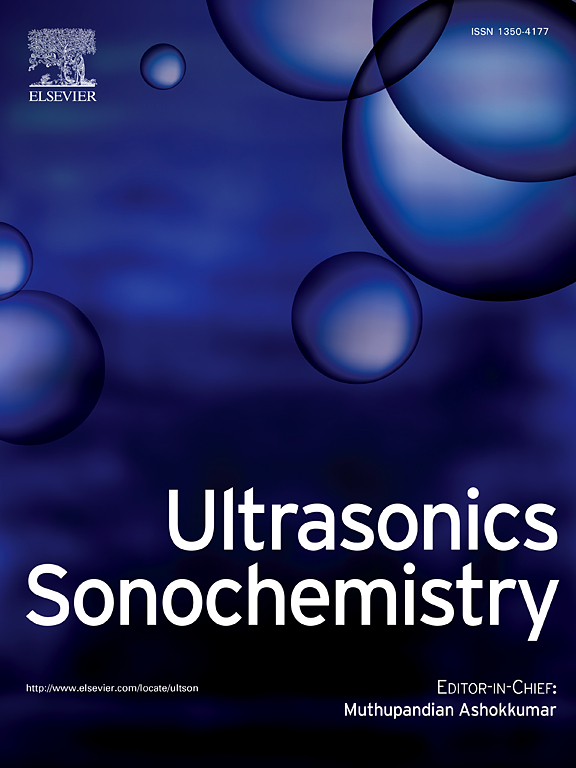Experimental and Eulerian-Lagrangian numerical investigation on cavitation erosion characteristics in Venturi pipes with different divergent angles
IF 8.7
1区 化学
Q1 ACOUSTICS
引用次数: 0
Abstract
Hydrodynamic cavitation (HC) is widely found in fluid machinery and has emerged as a significant technology in several engineering fields. To investigate the erosion characteristics caused by HC, experimental tests under varying conditions are conducted in this study using a Venturi test section with different divergent angles. The qualitative erosion risk distributions under different conditions are represented through paint experiments, showing that the erosion risk increases as the divergent angle decreases. Subsequently, a Eulerian-Lagrangian multiscale cavitation model is adopted to simulate HC in the test section. This model directly resolves large-scale cavities using the volume of fluid (VOF) method and simultaneously tracks sub-scale discrete bubbles using a discrete bubble model (DBM). A modified aggressive indicator [Li et al., Int. J. Mech. Sci. 262, 108,735 (2024)] is incorporated into the multiscale cavitation model to account for the erosion power produced by multiscale cavitation behaviors, thereby reproducing the distribution of cavitation erosion risks. Simulations corresponding to the experimental conditions are conducted, and the results show that the simulated cavitation features align well with the experimental observations. Furthermore, the cavitation erosion risk distributions predicted by the present model agree well with the paint tests, confirming the reliability of our model.
不同发散角文丘里管空化侵蚀特性的实验及欧拉-拉格朗日数值研究
流体动力空化(HC)广泛存在于流体机械中,并已成为许多工程领域的重要技术。为了研究HC引起的侵蚀特性,本研究采用不同发散角的文丘里试验段进行了不同条件下的试验试验。通过涂漆实验表征了不同条件下的定性侵蚀风险分布,表明随着发散角的减小,侵蚀风险增大。随后,采用欧拉-拉格朗日多尺度空化模型对试验段HC进行模拟。该模型采用流体体积法(VOF)直接求解大尺度空腔,同时采用离散气泡模型(DBM)跟踪亚尺度离散气泡。一种改良的侵袭性指标[Li et al., Int.]j .机械工程。将多尺度空化模型纳入多尺度空化行为所产生的侵蚀功率,从而再现了空化侵蚀风险的分布。根据实验条件进行了模拟,结果表明模拟的空化特征与实验观测结果吻合较好。此外,该模型预测的空化侵蚀风险分布与涂料试验结果吻合较好,验证了模型的可靠性。
本文章由计算机程序翻译,如有差异,请以英文原文为准。
求助全文
约1分钟内获得全文
求助全文
来源期刊

Ultrasonics Sonochemistry
化学-化学综合
CiteScore
15.80
自引率
11.90%
发文量
361
审稿时长
59 days
期刊介绍:
Ultrasonics Sonochemistry stands as a premier international journal dedicated to the publication of high-quality research articles primarily focusing on chemical reactions and reactors induced by ultrasonic waves, known as sonochemistry. Beyond chemical reactions, the journal also welcomes contributions related to cavitation-induced events and processing, including sonoluminescence, and the transformation of materials on chemical, physical, and biological levels.
Since its inception in 1994, Ultrasonics Sonochemistry has consistently maintained a top ranking in the "Acoustics" category, reflecting its esteemed reputation in the field. The journal publishes exceptional papers covering various areas of ultrasonics and sonochemistry. Its contributions are highly regarded by both academia and industry stakeholders, demonstrating its relevance and impact in advancing research and innovation.
 求助内容:
求助内容: 应助结果提醒方式:
应助结果提醒方式:


